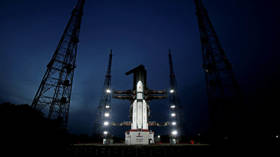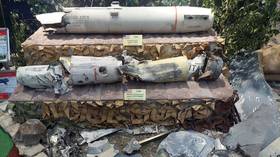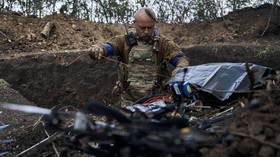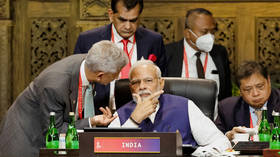Will Chandrayaan-3 catapult India to the big league in space?

India is all set to launch its latest Moon mission on Friday. Chandrayaan-3 will travel to the Moon’s south pole on the Launch Vehicle Mark 3 (LVM3) rocket from Satish Dhawan Space Centre off the country’s east coast. On Tuesday, the Indian Space Research Organisation (ISRO) concluded the launch rehearsal for Chandrayaan-3, simulating the entire preparation process over 24 hours.
Significance of the mission
If the mission is successful, India will become only the fourth country ever to make a controlled lunar landing and join the elite grouping of the US, the former Soviet Union and China. The mission is seen as a demonstration of India’s growing geopolitical ambitions in both national security and in alliances with other global players, all amid the government’s recent move to privatize space missions from India.
ISRO, which was established in 1969, has estimated the mission’s cost at around $77 million (6 billion rupees). This is India’s second attempt to land a craft safely on the Moon, following a failed bid in 2019.
Last month, during Indian Prime Minister Narendra Modi’s first-ever state visit to the US, New Delhi also signed the NASA-led Artemis Accords on human and robotic exploration of the Moon. The White House said in a press release that data gathered by Chandrayaan-3 could come in handy for Artemis-backed human landings on the lunar surface.
LVM3 M4/Chandrayaan-3 Mission:Mission Readiness Review is completed.The board has authorised the launch.The countdown begins tomorrow.The launch can be viewed LIVE onhttps://t.co/5wOj8aimkHhttps://t.co/zugXQAY0c0https://t.co/u5b07tA9e5DD Nationalfrom 14:00 Hrs. IST…
— ISRO (@isro) July 12, 2023
Main objectives of the mission
According to the mission’s official website, its main objectives are to land safely on the surface of the Moon, to display rover operations and to perform scientific experiments. Vikram is likely to reach Moon’s surface by the end of August, according to ISRO officials. NASA has said that the mission calls for a propulsion module to ferry the lander Vikram and the rover Pragyan together to the Moon’s south pole. Initially, the module will enter lunar orbit and maneuver about 100 kilometers above the surface and, later, Vikram will separate from it and aim for a soft landing on the lunar surface.
The lunar vehicles Vikram and Pragyan will collect scientific evidence from the surface for 14 Earth days, the same duration as a single day on the Moon. The propulsion module will carry out its own scientific experiment on Earth. The journal Nature reported that the experiment seeks to gather data on the polarization of light reflected by Earth, to allow researchers to look for other planets “with similar signatures.”
Key features of Vikram and Pragyan
Chandrayaan-3 has a lot of unique characteristics, according to ISRO. The lander will carry a payload called Chandra’s Surface Thermophysical Experiment (ChaSTE) to measure thermal conductivity and temperature on the lunar surface. The Instrument for Lunar Seismic Activity (ILSA) is to detect moonquakes. Langmuir Probe can estimate the density and variation of plasma, or superheated gas, in the Moon's environment.
A Laser Retroreflector Array has been provided by NASA to measure distances using laser ranging. The Alpha Particle X-ray Spectrometer (APXS) looks for elements in the lunar soil and rocks. Laser Induced Breakdown Spectroscope (LIBS) will examine the chemical and elemental composition of the Moon’s surface.
Pragyan, a rectangular chassis mounted on a six-wheel rocker-bogie wheel drive assembly, is tasked with sending communications to Earth through Vikram. It, too, has certain unique characteristics, such as an Alpha Particle X-ray Spectrometer (APXS) to study lunar soil and rocks. A device called LIBS examines the chemical and elemental composition of surface matter.
The propulsion module, at more than two tons, is a box-like structure with one large solar panel mounted on one side and a large cylinder on top, will also carry a Spectro-polarimetry of Habitable Planet Earth (SHAPE) payload to study particular measurements of Earth from the lunar orbit.
Past Moon missions & lessons learnt
Chandrayaan-1, India’s first mission to the Moon, launched in October 2008 and achieved lunar orbit on November 8. The first mission is best known for finding evidence of water ice on the Moon. Chandrayaan-2 was the second mission that was launched on July 22, 2019 and made it to lunar orbit on August 19. Later, on September 6, Chandrayaan-2 released the Vikram moon lander, but contact with it was lost with the craft.
The current mission is steeped in learnings from the failures of Chandrayaan-2, which occurred due glitches in both software and hardware. ISRO Chairman S Somanath spoke of changes that the space agency has put in place for Friday’s mission. “The main lacuna in the Chandrayaan-2 mission was that there were off-nominal conditions that were initiated in the system. Everything was not nominal. And the craft was not able to handle the off-nominal condition for a safe landing,” he told NDTV news channel.
Significantly, the new mission has been designed to land successfully while factoring in the failures of key elements such as sensors, algorithms, and calculations. The landing area has been expanded to four km by 2.5 km and the spacecraft will carry more fuel and additional solar panels. These new features have been added to ensure power generation and take the landing orientation out of the equation, the agency said.













